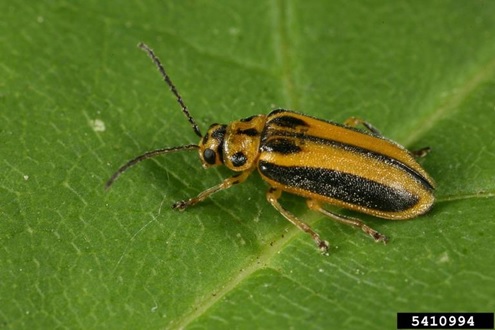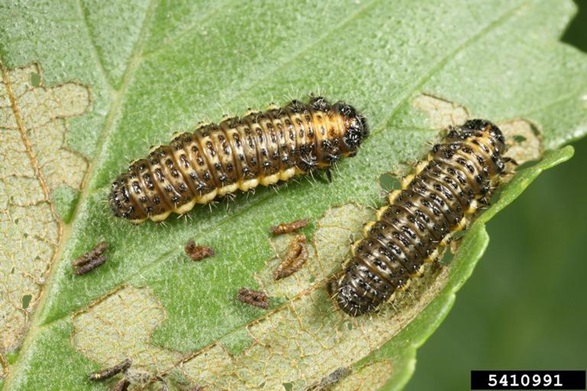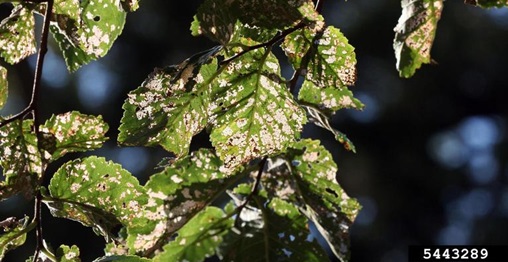Elm Leaf Beetles
ENTFACT-400: Elm Leaf Beetles | Download PDF
by Jonathan L. Larson, Extension Entomologist
University of Kentucky College of Agriculture
Fast Facts
- The elm leaf beetle is a pest of elm trees, those that are grown in cities and towns are more susceptible to damage
- Both adults and larvae damage the leaves, larvae skeletonize leaves while adults chew blotchy holes in the center of leaves
- There are usually two generations per year, with the first one being the more damaging to trees but the second generation may attempt to overwinter in buildings
- Management is dependent on the context, but insecticides can be applied to tree leaves or trunks to prevent damage, while pest proofing can keep them out of homes
Potential Hosts
The elm leaf beetle feeds on elm trees and closely related zelkova. There are differences in attraction/damage to different varieties of elm, Siberian and English elms are the most likely to be fed on.
Symptoms and Pest Description
This pest is a problem both as a larva and as an adult. As the immatures develop, they feed on leaves, consuming the green tissue between the veins of the leaf. As a result, leaves become lacy and skeletonized. They may also brown and fall off the tree. The adult beetles will chew irregularly shaped holes in the middle of leaves. There is similarity between the damage caused by elm leaf beetle and European elm flea beetle. European elm flea beetle damage is called “shot hole damage” as their chew marks are small irregular holes with edges that seem singed. Elm leaf beetle feeding usually lacks this this singed appearance.
Aside from the damage they cause to trees, adult beetles can be fall invader pests. While they overwinter, they do not feed or mate and won’t cause any direct damage in homes or buildings.
Adult beetles are small, around ¼ inch, but have distinctive coloration and markings. They are yellow to olive green, with a dark stripe down the center of the top wings and thicker dark stripes on the outer edge of the wings. Behind the head, there are four black spots. The grubs are also distinct looking, with a black yellow coloration punctuated with hardened black spots across the back.

Life Cycle in Kentucky
There are at least two generations per year in Kentucky, the first generation causes more serious damage than the second. Adult beetles overwinter in protected areas. Outdoors, this can include wood piles, mulch, or brush piles. They can also take advantage of openings in homes or other buildings to gain access to shelter. In the spring, elm tree buds will begin to appear and at that time, the overwintered beetles will begin to emerge and move to trees to feed and mate. As elm leaves grow and develop, the beetles will start to lay masses of 5-25 yellow, spindle shaped eggs.
After about two weeks, the eggs will hatch, and the new larvae will begin to feed and develop. Feeding continues for about three weeks before the larvae will start to crawl down the tree to pupate. Most will pupate in the soil beneath the host tree, though some may use cracks in the tree’s bark.

After about two weeks as a pupa, new adults will emerge to produce the second generation of eggs. The larvae that hatch will feed for about three weeks, pupate and emerge as the adults that will overwinter.

Management
Elm leaf beetles are sporadic but possibly serious pests if trees deal with heavy infestations year after year. Unfortunately, there are limited options for biological control, outside of what occurs naturally, or for mechanical control.
If you have trees that see consistent issues, a systemic imidacloprid soil drench or soil injection treatment will go from the tree roots through the plant and provide season long protection. Apply imidacloprid in the spring as leaves begin to expand, always check the label for rates based on the diameter of your tree. Alternatively, acephate, a foliar systemic, can be applied around the same time.
If a tree is already infested and damage is already present in early or late summer, contact insecticides can be applied to leaves. Bifenthrin, cyfluthrin, deltamethrin, lambda-cyhalotrhin, and permethrin are all labeled for use against this pest. Foliar applications do have the potential to drift to other plants nearby or to float down on the applicator, follow all label precautions to ensure safety. Spinosad or Neem may be used as organic alternatives.
A different option would be treating for larvae as they migrate down the tree trunk in search of pupation sites. This would prevent the production of the second generation of beetles. Use one of the previously mentioned contact insecticides and treat in a band around the tree where the lowest branches meet the trunk. In Kentucky, this application would usually be done in late May or early June.
Finally, if dealing with these insects inside of a home, do not use “bug bombs” to manage them. Instead, focus on finding key entry points and sealing them with improved screening or caulking. Entry points can also be treated with insecticides such as permethrin or bifenthrin as spot sprays. If beetles are found indoors, simply vacuum them up or sweep them out of the house.
Revised: 1/25
CAUTION! Pesticide recommendations in this publication are registered for use in Kentucky, USA ONLY! The use of some products may not be legal in your state or country. Please check with your local county agent or regulatory official before using any pesticide mentioned in this publication.
Of course, ALWAYS READ AND FOLLOW LABEL DIRECTIONS FOR SAFE USE OF ANY PESTICIDE!
Images: University of Kentucky Entomology unless otherwise indicated.
